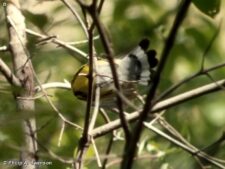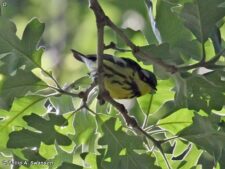
5.0 inches long. The Magnolia Warbler is a strikingly plumaged bird. The bright yellow undersides have heavy black streaks that often form a necklace in spring males. The undertail coverts are white. The wings and upperparts are gray and the rump is yellow. The male has a white patch on the wing while the duller female has two white wing bars. The face is black with a white eyebrow. The black tail is often fanned showing a distinctive white band. The Magnolia Warbler is similar to many Dendroica warblers in having a marked difference between breeding and fall plumage. In fall its head is grayish with a white eye ring but no white eyebrow. The streaking is also reduced. Immature birds are similar to adult fall birds.
The Magnolia Warbler is an uncommon migrant in the area. It is seen in mid to late May and again in mid August through late September.
The Magnolia Warbler often stays low in trees while actively feeding. It fans its tail showing white tail band. When catching flying insects it can come very close to the observer. One suggested name for this bird was appropriately Black and Yellow Warbler. The song is a short series of musical notes that sounds like “weety, weety, weety, wee”.
Disclaimer: The content of NatureSearch is provided by dedicated volunteer Naturalists of Fontenelle Forest who strive to provide the most accurate information available. Contributors of the images retain their copyrights. The point of contact for this page is: Phil Swanson.



